T8 - Grey Matter
1/228
There's no tags or description
Looks like no tags are added yet.
Name | Mastery | Learn | Test | Matching | Spaced |
|---|
No study sessions yet.
229 Terms
What is the Central Nervous System?
Mostly made up of relay or immediate neurones. These are neurones which only have connections with other neurones. These CNS is made up of the brain and spinal cord.
Acts as a central coordinating centre for the impulses that come in from, and sent out to, any part of the body.
What is the peripheral nervous system made up of?
Made up of motor and sensory neurones. These neurones connect the CNS to receptors and effectors. Can be further divided into the autonomic nervous system and somatic nervous system
Why must organisms respond to changes in their internal/external environments in order to survive?
Organisms need to find favourable external conditions eg avoiding locations that are too hot or cold, find food, avoid harm eg from predators or high blood glucose
What is the somatic nervous system?
The motor neurones of the somatic nervous system contact effectors that are under voluntary (conscious) control. Mostly they contact the skeletal muscles
What is the autonomic nervous system?
Controls unconscious activities. This includes the heart rate, the smooth muscle in the digestive systems and airways and glands. Plays a large part in the mechanisms of homeostasis. It is further divided into the sympathetic and parasympathetic nervous system. PNS conserves energy, whilst the sympathetic preps the body for activity. They are antagonistic
What does specialised receptor cells detect?
Detects changes in the environment or stimuli (singular stimulus).
They send signals via either the nervous system or the hormonal system to the body’s coordination in the brain or spinal cord.
These signals are sent onto the parts of the body which respond, known as effectors (eg muscles or glands)
Where are receptor cells located?
Located in the sense organs, receptor cells can be found inside the body
What happens within the nervous system?
Allows detection of stimuli in our surroundings and the coordination of the body’s responses to the stimuli. Info is sent through the nervous system in the form of electrical impulses that pass along nerve cells (neurones). A bundle of neurones is known as a nerve.
What are the three different types of neurones?
Sensory- Carry impulses from receptors to the brain and spinal cord in CNS
Relay-Found entirely within the CNS and connect sensory and motor neurones
Motor-Carry impulses from the CNS to effector muscles or glands

What does the nerves do?
Connect the receptors in the sense organs with the CNS, and connect the CNS with effectors.
What is the following pathway that nerve impulses pass through the nervous system?
Stimulus→ receptor→ sensory neurone → CNS → motor neurone → effector
What is an example of a nerve pathway in action when the skin touches a hot surface?
Hot surface→ pain receptor in the skin of hand → sensory neurone → CNS → motor neurone → arm muscle
The muscle in the arm responds by contracting to move the hand away from the hot surface
What is the difference between the sympathetic nervous system and parasympathetic nervous system?
Sympathetic = Preps body for ‘fight or flight’ responses
Parasympathetic = Preps body for rest and digest
What is the difference between the autonomic nervous system and parasympathetic nervous system?
Autonomic = Involuntary, stimulates smooth muscle, cardiac muscle and glands
Somatic nervous system= Voluntary and stimulates skeletal muscle
What is the function of hormones in the hormonal system?
Contains hormones that are chemical substances/messenger produced by the endocrine glands and carried by the blood.
Transmit info from one part of an organisms to another and bring about change by altering the activity of one or more specific target organs
Why are hormones slower in action?
Slower in action than nerve impulses and are therefore used to control functions that do not need instant responses
What is the function of endocrine glands?
Produce hormones in animals (collectively known as the endocrine system) Can be stimulated to secrete hormones by the action of another hormone or by the arrival of the nerve impulse
What is the pathway of hormone action?
Stimulus → receptor → hormone → effector
Example: high blood sugar → cells in the pancreas → insulin → liver cells
What is the difference of the nervous system and endocrine system?
Nervous system = Contain nerves (neurones) , brain and spinal cord. Electrical impulse, very fast transmission, short effect (until nerve impulses stop)
Endocrine system = Glands, contain chemical hormone, slower. long effect (until hormone is broken down)
What are neurones?
-Are specialised cells of the nervous system → carry electrical impulses around the body. A bundle of neurones is a nerve
-Neurones or nerve cells carry electrical signals in the nervous system.
-A neurone is a single cell, a nerve is a more complex structure containing a bundle of the axons of many neurones surrounded by a protective covering
What are the structures within neurones?
Cell body = contains the nucleus and other organelles. It carries out all the normal functions of the cell (e.g protein synthesis and ATP production)
Dendrites = Branches of the neurone membrane which receives signals from other neurones
Axon= A long fibre. A single, long, thin extension that carries electrical signals away from the cell body, towards the synapses.
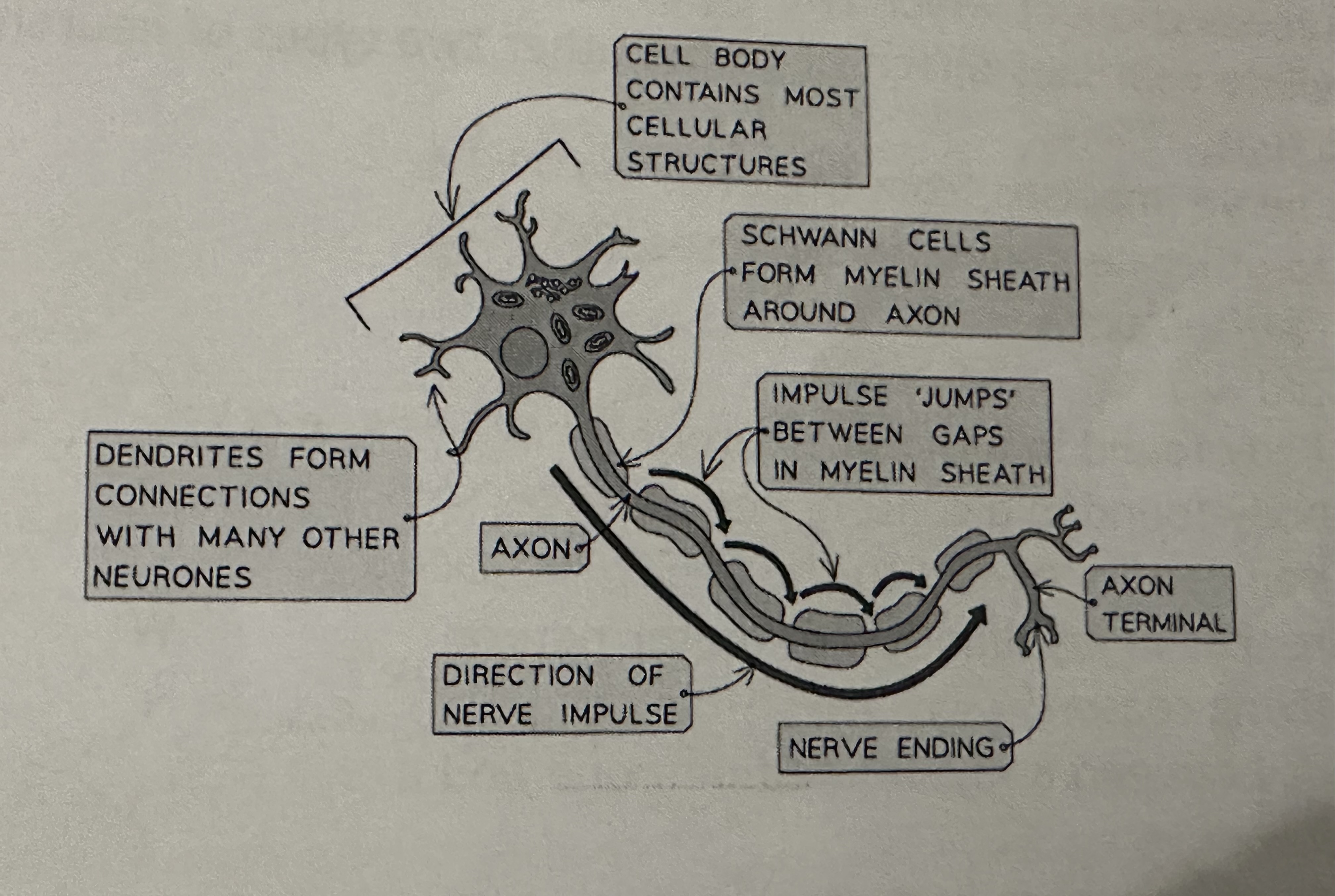
What is the structure of an axon?
Vary in length and are surrounded by a lipid and protein covering → the myelin sheath, which is produced by the Schwann cells (which acts as an electrical insulator)
The section of neurone that connects the cell body with the CNS is the axon
What does Schwann cells do?
Schwann cells wrap themselves around the axon. In non-myelinated neurones. the axon is not insulated by Schwann cells. The impulses travels more slowly as it moves through the entire length of the axon
What are the Nodes of Ranvier?
-Uninsulated gaps between the Schwann cells known as Nodes of Ranvier (the periodic gap on the myelin sheath of axon that facilitates the rapid conduction of nerve impulses).
-Electrical impulses in myelinated cells do not travel down the whole axon, but jump from one node to the next, speeding up impulse transmission
What does it mean if a neurone is non-myelinated?
Means that the axon is not insulated by Schwann cells. The impulse travels more slowly as it moves through the entire length of the axon
What are nerve endings?
Found at the end of the axon (axon terminal). The never endings at the axon terminals allow neurones to connect to and receive impulses from other neurones, forming a network for easy communication
What is the structure of motor neurones?
A large cell body at one end that lies within the spinal cord or brain.
Many highly-branched dendrites extending from the cell body, providing many connections with the axon terminals of other neurones.
Cell body of such neurons are located in the white matter of the spinal cord
What is the function of motor neurones?
Conduct impulses from the CNS to the effector organs, muscles or glands
Has a single large axon that carries the impulses from the interneuron in spinal cord → effector organ located at a distance
In the somatic nervous system, the neurones are fast conducting, supplying the skeletal muscles
In the autonomic nervous system, the neurones are slower conducting. They supply smooth muscle in the glands, cardiac muscle in the heart and glands
What is the function of relay neurones?
Conduct impulses within the CNS from sensory neurones to effector (motor) neurones.
It’s a short neurone with axons and highly branched dendrites
Also known as the interneuron
Are present in the white matter of the spinal cord.
Receive info from the sensory neuron, process this info within a few milliseconds + decide about the response → info regarding the response is fed to the motor neuron to be transmitted to the effector organ
What is the structure and function of sensory neurones?
-Conduct impulses from receptors and sense organs to the CNS. Usually myelinated and thus fast conducting.
-A cell body that branches off the middle of the axon with dendrites that are attatched to a receptor cell
-Have cell bodies in the dorsal root ganglion in the spinal cord
What is a dendron?
The section of neurone that links the axon terminal (at the receptors) with the cell body. It delivers the electrical impulse to the cell body
What are reflex actions performed by?
Performed by components of the PNS (peripheral nervous system)
What happens once the body detects a stimulus?
The body responds unconsciously → an action is performed, as info is sent to the brain so that the person becomes aware of what has happened
What are reflexed controlled by?
Simple action pathways → the pathway is usually localised to the part of the body where the reflex occurs → means we can respond to stimuli quickly since signals do not have to go to the brain and back
Why do reflexes not involve many synapses?
They are slow to transmit across neurones, and this speed allows reflexes to be effective in protecting the body from harm.
-Simplicity of reflex means that it does not have to be learnt and is effective from birth
What are the two types of reflexes?
Somatic
Visceral
What does somatic reflexes involve compared to visceral?
Somatic= involve skeletal muscles and is voluntary
Visceral= Involves glandular or smooth and cardiac muscle
What is the process of the reflex arc?
1) Receptors detect a stimulus and generate a nerve impulse
2) Sensory neurones conduct a nerve impulse to the CNS along a sensory pathway
3) Sensory neurones enter the spinal cord through the dorsal route
4) Sensory neurone forms a synapse with a relay neurone
5) Relay neurone forms a synapse with a motor neurone that leaves the spinal cord through the ventral route
6) Motor neurone carries impulses to an effector which produces a response
What is the function of a receptor?
Serves to detect the stimulus that is any change in the external environment. It’s the first component of the reflex arc. They detect physical change and turn it into an electrical signal (signal is passed onto a sensory neuron)
Give examples of common receptors
Pain receptors, Thermoreceptors, Mechanoreceptors and chemoreceptors
What is the function of the effector organ?
-The one that acts in response to the stimulus
-In the case of the reflex arc, the effector organ is almost always a muscle fibre or a group of muscle fibres
-It is innervated by a motor neuron carrying info about the response
What is the pupil reflex?
It is how the amount of light entering the pupil is controlled by a reflex action
How does the pupil change in response to bright or dim light?
Size of pupil changes → controlled by the muscles of the iris.
What are the antagonistic muscles in the iris and what are they both controlled by?
Radial and circular muscles → BOTH controlled by the autonomic nervous system
What reflex is the radial and circular muscles controlled by?
Radial → controlled by sympathetic reflex → contract to constrict pupil
Circular → Controlled by parasympathetic reflex → contract to dilate pupil
Explain the difference in what happens in the pupil in dark and bright light
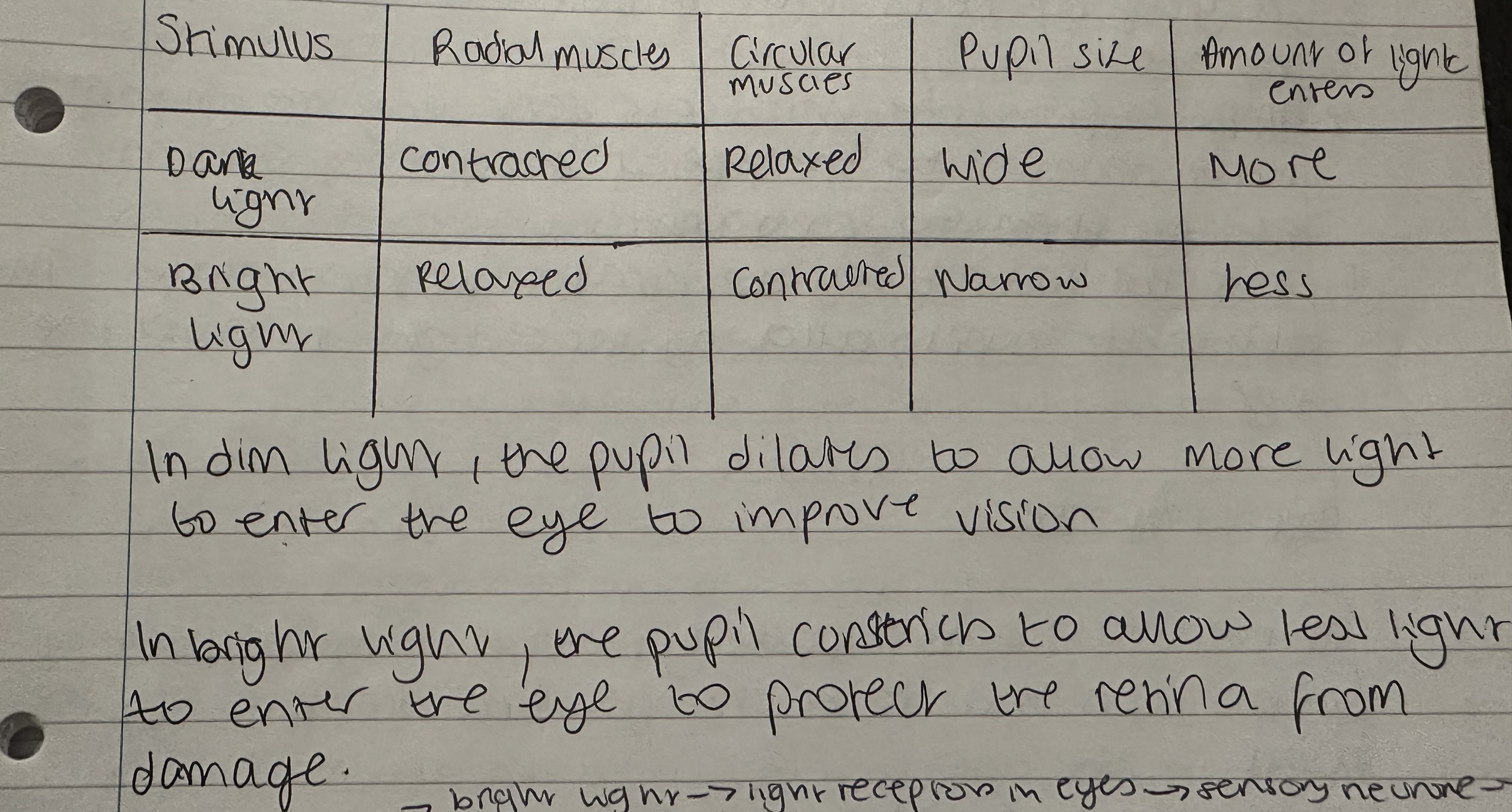
Summarise the reflex pathway of the pupil in bright light
Bright light → light receptors in eyes → sensory neurone → CNS → motor neurone → circular muscles in iris
Explain in detail the reflex pathway involved in pupil constriction?
1) High light levels strike in the photoreceptors in the retina
2) Nerve impulses pass along the sensory neurones in the optic nerve to the CNS
3) A number of diff sites within the CNS, including a group of cells in the midbrain coordinate a response
4) Impulses from these cells are sent along the parasympathetic motor neurones to the circular muscles of the iris, causing them to contract
5) At the same time, the radial muscles relax. This constricts the pupil, reducing the amount of light entering the eye
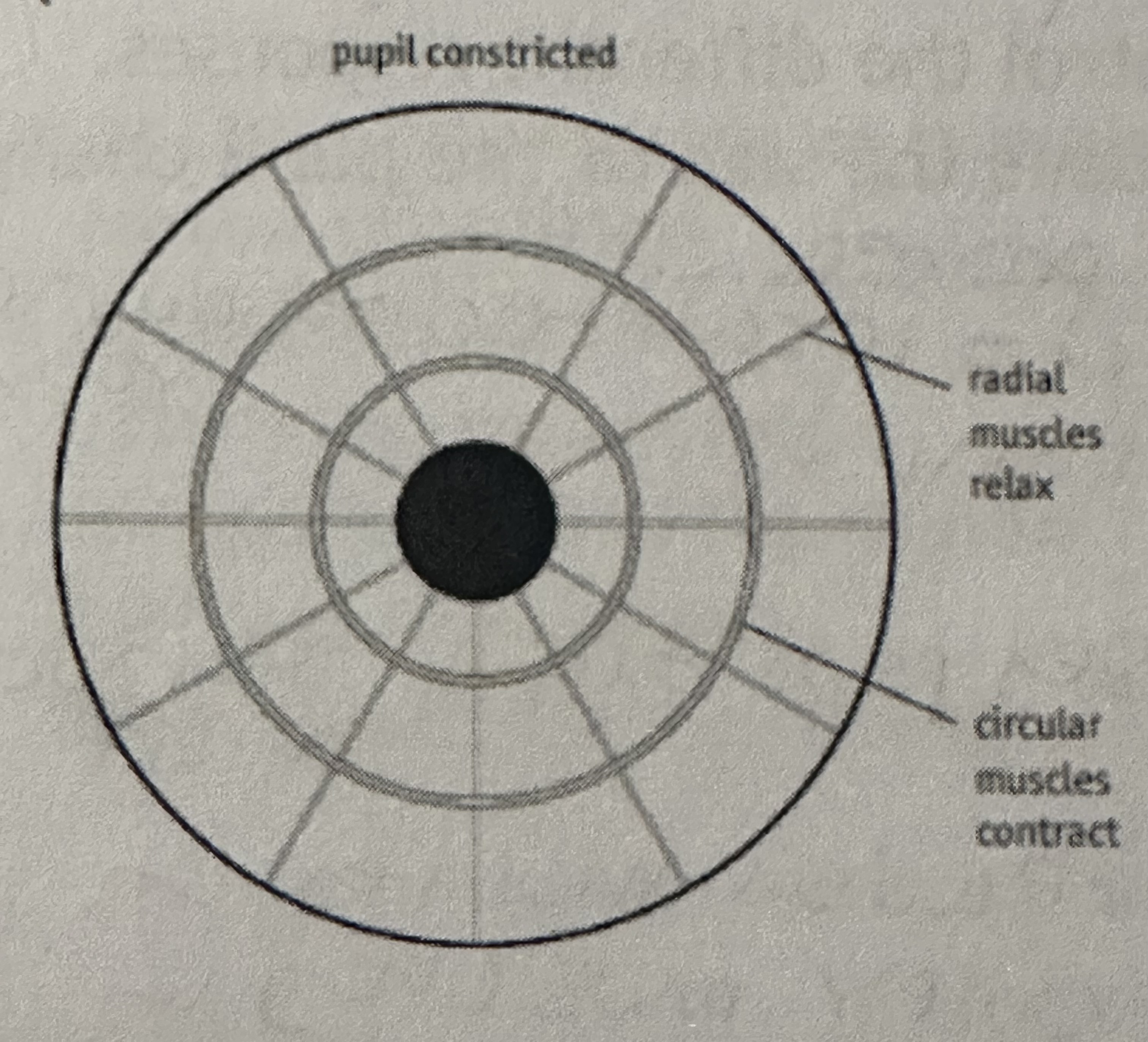
Explain the reflex pathway involved in pupil dilation
1) Low light levels are detected by photoreceptors in the retina
2)Nerve impulses pass along the sensory neurones in the optic nerve to the CNS
3) A number of different sites within the CNS, including a group of cells in the midbrain coordinate a response
4) Impulses from these cells are sent along the sympathetic motor neurones to the radial muscles of the iris causing them to contract
5) At the same time, the circular muscles relax. This dilates the pupil, allowing more light to enter the eye

What does changing pupil diameter enable?
Enables the eye to control the amount of light hitting the retina
What do neurones transmit?
Electrical impulses, which travel along the neurone cell surface membrane from one end of the neurone to the other (note: impulse is NOT an electrical current that along neurones as if they were wires)
What is an impulse?
A momentary reversal in the electrical potential difference (or voltage across a membrane/membrane potential) across the neurone cell surface membrane. Transmission of nerve impulses is essential to survival → allows body to detect and respond to stimuli
What are the different states of membrane potential across a neurone cell surface membrane during the transmission of a nerve impulse?
Resting potential
Action Potential
What is resting potential?
-In a resting axon (one that is not transmitting impulses) the inside of the axon always has negative electrical potential compared to outside of axon
-Difference in charge between the inside + outside of the neurone is due to diff numbers of ions on each side of the neurone cell surface membrane
-When there is a difference in charge across a membrane, we say the membrane is polarised
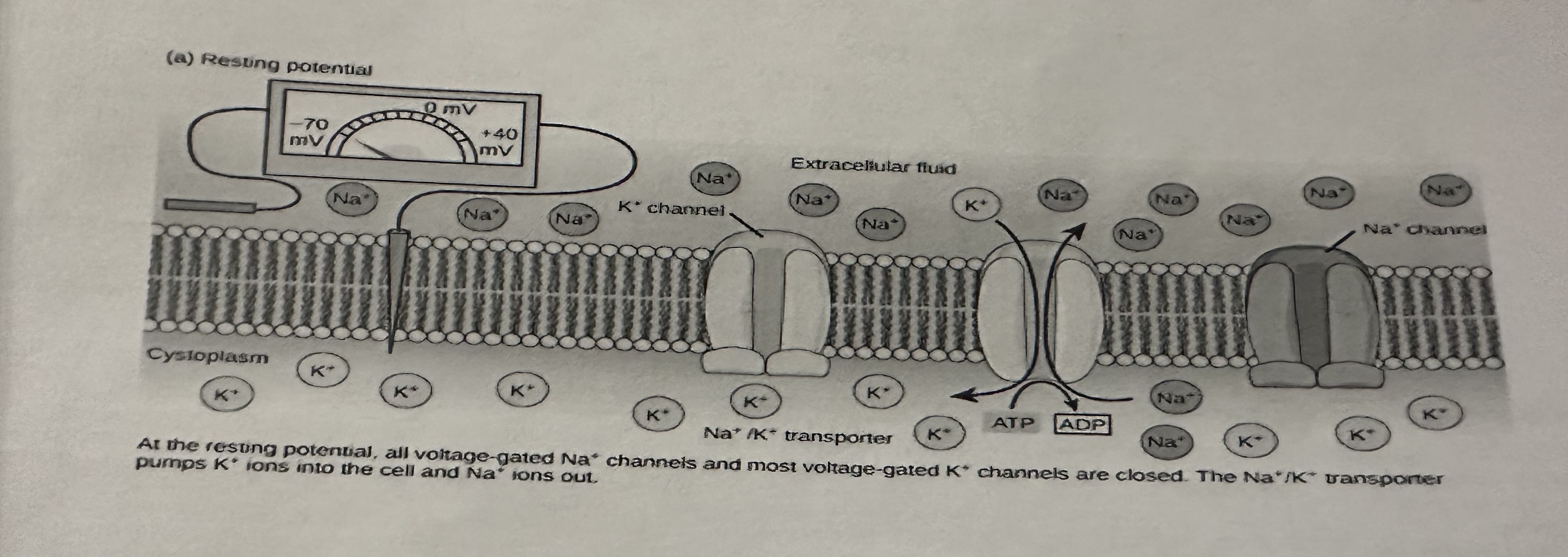
What is the potential difference in charge across the membrane when there are no impulses (resting potential of neurone)?
-70mV
What are the two factors that contribute to establishing and maintaining resting potential?
Active transport of sodium ions and potassium ions
A difference in membrane permeability of Na+ and K+ ions
What happens during the active transport of sodium ions and potassium ions?
-Carrier proteins called sodium-potassium pumps are present in the cell surface membranes of neurones
-These pumps use ATP to actively transport sodium ions out of the axon and potassium ions into the axon
-The two types of ions are pumped at an unequal rate; for every 3 Na+ ions that are pumped out of the axon, only 2 potassium ions are pumped in. This creates a concentration gradient across the membrane for both sodium ions and potassium ions
Explain why there is a difference in membrane permeability to sodium ions and potassium ions
-Because of conc gradient generated by sodium-potassium pumps, both Na+ and K+ will diffuse back across the membrane
-The neurone cell surface membrane has Na+ channels and K+ channels that allow Na+ and K+ to move across the membrane by facilitated diffusion
-Neurone is less permeable to Na+ than K+, so K+ inside the neurone can diffuse out at a faster rate than Na+ can diffuse back in
-This results in more positive ions on the outside of the neurone than on the inside, generating a negative charge inside the neurone in relation to the outside. The result of this is that the neurone has a resting membrane potential of around -70mV
Summarise what happens during resting potential
1) NA+/K+ pump conc gradients across the membrane
2) K+ diffuse out of the cell down the K+ conc gradient, making the outside of the membrane positive and the inside negative creating a potential diff
3) The p.d will pull K+ back into the cell
4) At -70mV, the 2 gradients counteract each other and there is no net movement of K+
How do you initiate a nerve impulse in a neurone?
The membrane needs to be depolarised → the reversal of the electrical p.d across the membrane → depolarisation of the membrane occurs when an action potential is generated → leads to the reversal of resting potential from around -70mV to around 40mV
What is an action potential?
-The potential electrical difference produced across the axon membrane when a neurone is stimulated
-Involves the rapid movement of sodium ions and potassium ions across the membrane of the axon
-It is when a stimulus is received by a receptor, its energy causes a temporary reversal of the charge on the axon membrane. Goes from -70mV to +40mV, where the membrane is depolarised

Why are some of the ions channels in the membrane of a neurone voltage gated?
Means that they open and close in response to charges in the electrical potential across the membrane.
Voltage gated ion channels are closed when the membrane is at rest, but they are involved in the generation and transmission of action potentials (note: not all channels in a neurone membrane are voltage gated)
What happens when a neurone is stimulated (action potential is generated)?
1) A small number of sodium ions channels in the axon membrane open
2) Sodium ions begin to move into the axon down conc gradient. During resting potential, there is a greater conc of Na+ outside the axon than inside due to action of sodium-potassium pumps
3) This reduces the p.d across the axon membrane as the inside of the axon becomes less negative
4) If p.d reaches around, -55mV (threshold potential) more Na+ channels open, leading to further influx of Na+. The second set of Na+ channels are voltage gated channels. Action Potential is only initiated if the threshold potential is reached
5) Once the charge has been reversed from -70mV to 30mV, the membrane is said to be depolarised and an action potential has been generated
Summarise what occurs during an action potential
1) When a neuron is stimulated & reaches a threshold of -55mV, it can cause the voltage dependent Na+ channels to open. At restingP, these channels are blocked by gates
2) As Na+ diffuse into the axon along their electrochemical gradient (bc they are positively charged) they trigger a reversal in the p.d (restingp becomes negative)
3) The opening of more gates increase depolarisation further (an example of positive feedback)
4) The p.d across the membrane reaches +40mV
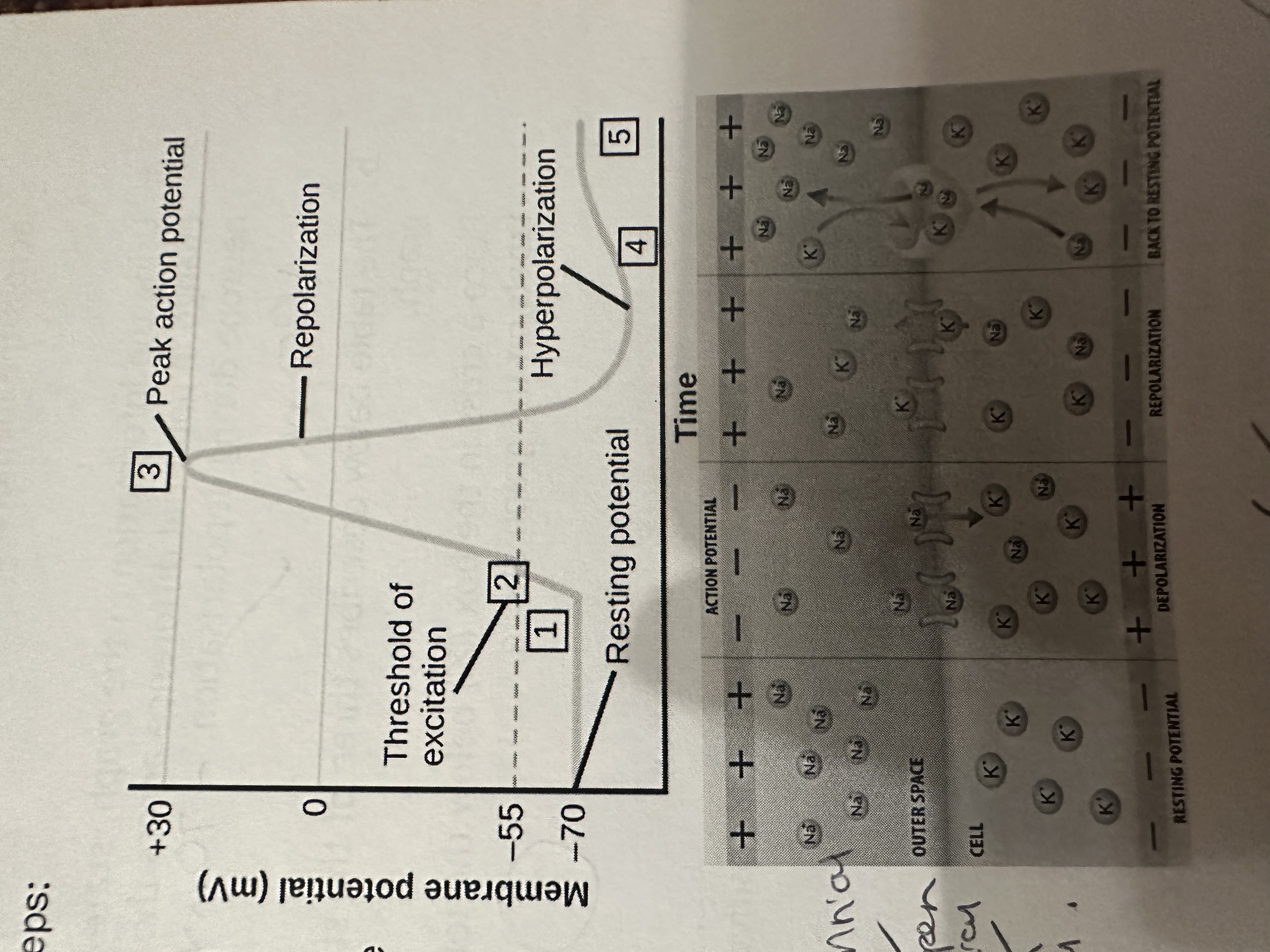
What happens if depolarisation does not surpass the threshold potential?
There will be no action potential generated within the neurone. This property is referred to as all-or-nothing. Channels that change shape (open or close) depending on the voltage across the membrane called voltage gated channels. The sodium channel proteins open at around -55mV
What is repolarisation?
-Once voltage gated Na+ channels spontaneously close, and the voltage K+ channels open, the electrical gradient preventing the outward movement of K+ ions is now reversed, so more K+ channels open. K+ diffuse out of the axon down their conc gradient
-The movement of K+ ions causes the inside of the axon to become negatively charged again, a process known as repolarisation of the axon
-This reduces the charge, resulting in the inside of the axon becoming more negative relative to the outside
What is hyperpolarisation?
-There is a short period during which the membrane potential is more negative than resting potential
-The outward diffusion of the K+ ions causes an overshoot of the electrochemical gradient, with the inside being more negative than usual: up to -90mV
-The gates on the voltage dependent K+ channels close and the sodium-potassium pumps reactivate to restore the conc gradient. Resting potential is re-established
What is the refactory period?
-The period during which the membrane is hyperpolarised.
-This means it is unable to generate any new action potentials. This makes the action potential discrete events and means the impulse can only travel in one direction.
-This is essential for the successful and efficient transmission of nerve impulses along neurones
-The voltage gated K+ channels then close, and the sodium-potassium pumps work to restore resting potential, only once resting potential is restored can the membrane be stimulated again
Why is the refactory period important?
-Ensures impulses are discrete and don’t overlap
-Action Potentials travel in one direction
-It limits the number of impulse transmissions. This is important to prevent over reaction of a stimulus and therefore overwhelming the senses
What is the transmission of an action potential?
-Once AP is generated, it can be propagated or transmitted along the length of the axon. The depolarisation of the membrane at the site of the 1st AP causes Na+ ions to diffuse, along the cytoplasm into the next section of the axon, depolarising the membrane in the new section, causing voltage gated Na+ channels to open
-This triggers another AP in this section → this process repeats along the length
-The AP is said to move along the axons in a wave of depolarisation.
-In the body, this allows AP to begin at one end of an axon and then pass along the entire length of the axon membrane
What is the formation of AP?
-A stimulus causes the target cell to depolarise toward the threshold potential
-If the threshold is reached, the Na+ channels open and the membrane depolarises (positive feedback)
-At +40mV K+ channels open and K+ begins to leave the cell. At the same time, Na+ channels close. The cell begins to repolarise
-The membrane becomes hyperpolarised as K+ ions continue to leave the cell. The hyperpolarisation membrane is in a refactory period and cannot fire. The K+ channels close and the Na+/K+ pump restores the resting potential
What is the all-or-nothing principle?
-A stimulus is weak only if a few sodium ion channels will open and the membrane won’t be sufficiently depolarised to reach the threshold potential.
-If a stimulus is strong enough to raise the membrane potential above the threshold potential then an AP will be generated
-An impulse is only transmitted if the initial stimulus is sufficient to inc the membrane potential above a threshold potential
How is stimulus size detected by the brain?
The intensity of a stimulus increases, the frequency of AP’s transmitted along the neurone increases. This means that a small stimulus may only lead to one AP, while a large stimulus may lead to several AP’s in a row
What are the Nodes of Ranvier?
The gaps between the myelin sheaths, these are the only places depolarisation can occur.
As ions flow across the membrane at one node during depolarisation, a circuit is set up which lowers the p.d at the next node, triggering an AP
The AP effectively jumps from one node of Ranvier to the next. This is much faster than a wave of depolarisation
Jumping conduction is called saltatory conduction
What is the speed of conduction of an impulse determined by? with explainations?
Presence of myelin = Myelination inc transmission speed through saltatory conduction (found in longer neurones that cover long distances)
Absence of myelin= Non myelination- found in neurones that cover very short distances
Diameter=Bigger diameter=faster the impulse due to less resistance
Temperature= The higher the temp →the faster the impulse due to ions diffusing faster across the membrane. If temp is too high=then it can cause the carrier proteins to become denatured
What is myelin?
An insulator and therefore prevents ions from moving across it. Insulating=increasing the speed at which AP can travel
What is the result of saltatory conduction?
Myelinated neurones transmit AP much faster than non-myelinated neurones. It is much more energy efficient as less ATP is used during repolarisation
There are diff mechanisms used to communicate the intensity of a stimulus, so what does size of stimulus affect?
Affects frequency of impulses and the number of neurones in a nerve that are conducting impulses. Irrespective of strength of stimulus, weak activations/stimuli that produce depolarisations that do not reach the threshold potential do not produce AP
How is drugs used to prevent transmission of impulses?
Bind to sodium ion channels (prevent opening/influx) which prevents membrane depolarisation and AP cannot be generated
How are Action Potentials propagated in non-myelinated neurones?
1) Depolarisation from an AP causes voltage-gated sodium channels to open further down the axon
2)As the wave moves down, earlier parts of the axon begin to repolarise
3) This happens all the way down the axon towards the terminal end
4) Behind the travelling wave, the axon is in the refactory period
5) Speed of conduction is relatively slow bc depolarisation must occur along the whole membrane of the axon
When sodium ions diffuse along the axon, within what type of cell does this occur?
Diffuse along the axon within the Schwann cells and the membrane at the nodes of Ranvier depolarises when the sodium ions arrive. The diffusion of sodium ions in this way is known as local currents/circuits
What are synapses? With examples
When neurones communicate with one another. One neuron sends a message to a target neurone via neurotransmitters examples incl : In sense organs, there are synapses between sensory receptor cells and sensory neurones.
In muscles, there are synapses between motor neurones and muscle fibres
What are the two types of neurotransmitters?
Excitatory
Inhibitory
What is the difference between excitatory vs inhibitory neurotransmitters?
Excitatory = Cause the postsynaptic neurone to depolarise, triggering an action potential e.g acetylcholine
Inhibitory= Result in hyperpolarisation of the postsynaptic neurone, meaning an action potential is unable to be triggered e.g GABA
What are the features of synapses?
Synaptic cleft
Presynaptic neurone
Postsynaptic neurone
Synaptic knots
Synaptic vesicles
Neurotransmitter receptors
What are neurotransmitters?
Nerve impulses are passed across the synaptic cleft by the diffusion of chemicals known as neurotransmitters (contained within vesicles) eg acetylcholine
What is the synaptic cleft?
Intercellular space between the axon terminal and the dendrite. Contains enzymes that break down the neurotransmitter
What is the presynaptic neurone?
Neurone along which the action potential has travelled. It is the neurone before the synapse and has a rounded end (synaptic knot)
What is the postsynaptic neurone?
Receives the impulse, it is the neurone after the synapse
What are synaptic knots?
Swollen end of the axon, containing many mitochondria, and smooth endoplasmic reticulum to synthesise neurotransmitters. Around 20-30nm
What are synaptic vesicles?
Receptor molecules, which the neurotransmitter binds to in the postsynaptic membrane
What are neurotransmitter receptors?
Receptor molecules which the neurotransmitter binds to in the post synaptic membrane
Explain the process of synaptic transmission
1) Incoming AP causes depolarisation in the synaptic knots
2) Membrane depolarises causing calcium voltage dependent channels to open. Ca+ flood into the synaptic knob along the electrochemical gradient
3) The influx of calcium ions causes synaptic vesicles to fuse with the presynaptic membrane
4) Neurotransmitter is released into the synaptic cleft
5) Neurotransmitter binds to the receptor site on the sodium ion channels and causes them to open. This allows Na+ to flood in along the electrochemical gradient
6) Depolarisation inside the post synaptic neurone must be above a threshold value. If the threshold is reached a new AP is sent along the axon of the post synaptic neurone
7) When released from the receptor the neurotransmitter will be taken up across the presynaptic membrane either whole or after being broken down. This closes sodium channels and prevents the post synaptic neurone from continuously generating new action potentials
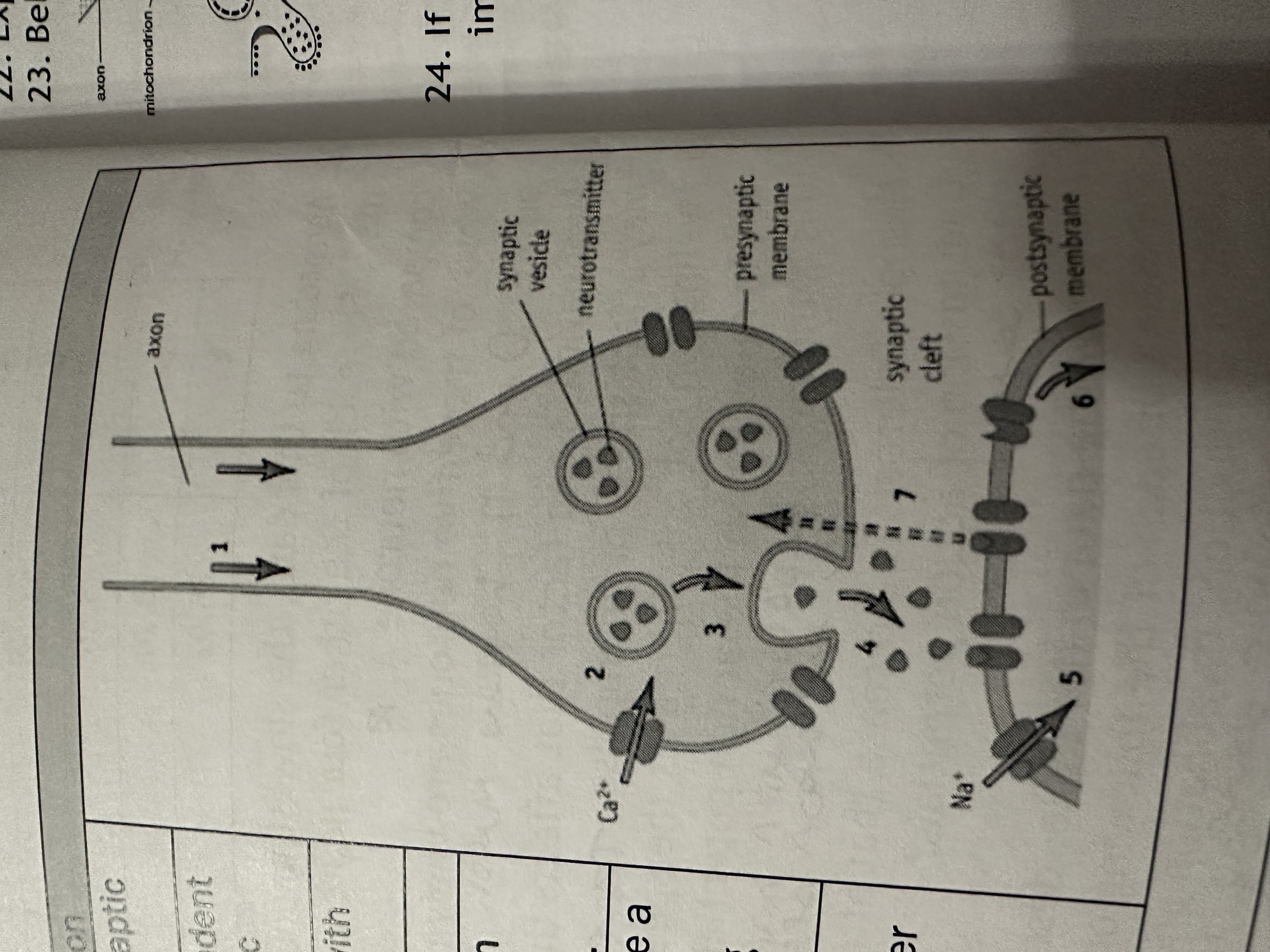
Why cannot electrical impulses ‘jump’ across the synaptic cleft?
When an AP arrives at the end of the axon of the presynaptic neurone the membrane becomes depolarised, causing voltage gated calcium ion channels to open
Why do calcium ions diffuse into synaptic knots?
To move towards the presynaptic membrane, where they fuse and release chemical messengers (neurotransmitters) into synaptic cleft by exocytosis. Common neurotransmitter is acetylcholine
What happens after neurotransmitters diffuse across the synaptic cleft?
Bind with receptor molecules on the postsynaptic membrane, which causes associated sodium ion channels on the postsynaptic membrane to open, allowing Na+ ions to diffuse into the postsynaptic cell
Why is enough neurotransmitter molecules needed to bind with receptors on postsynaptic membrane?
In order for an AP to be generated which then travels down the axon of the postsynaptic neurone.
Whether or not an AP is generated depends on whether or not threshold potential is reached, which in turn depends on the n. of AP arriving ay the presynaptic knots → Many AP will cause more neurotransmitter to be released by exocytosis
What does a large amount of neurotransmitter cause?
Cause many sodium ion channels to open. Many sodium ion channels opening will allow a large influx of sodium ions, increasing the likelihood of threshold being reached. Neurotransmitters are then broken down to prevent continued stimulation of the postsynaptic neurone
What breaks down acetylcholine and what is the synapse that involves acetylcholine?
-Enzyme that breaks down acetylcholine is acetylcholinestrase.
-A synapse involving acetylcholine is a cholinergic synapse
How is acetylcholine recycled?
Acetylcholinestrase hydrolyses acetylcholine into choline and acetate (ethanoic acid). Choline and ethanoic acid diffuse back across the cleft into the presynaptic bulb. This allows neurotransmitter to be recycled